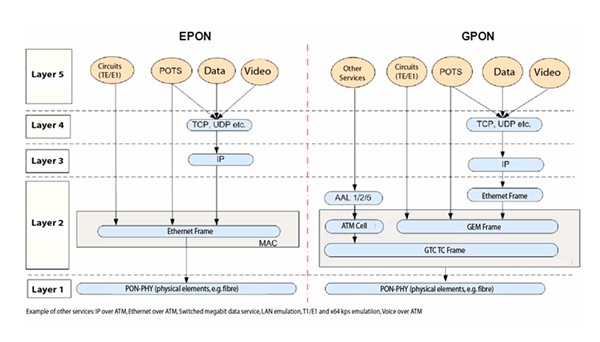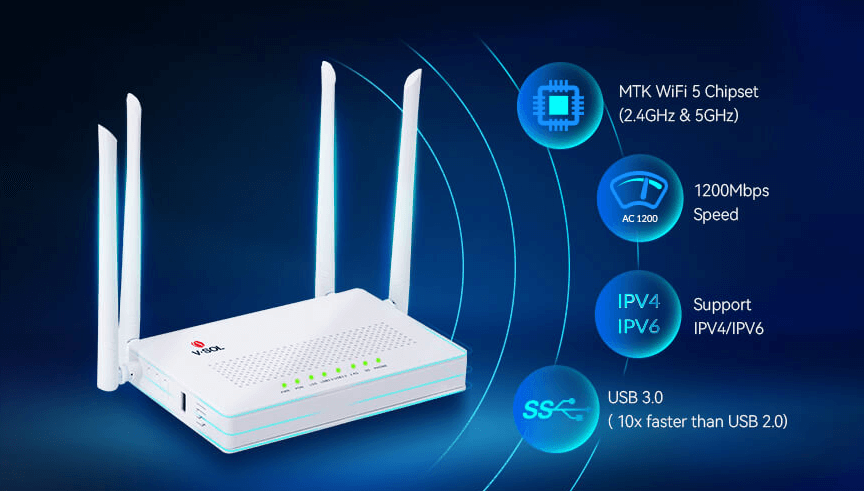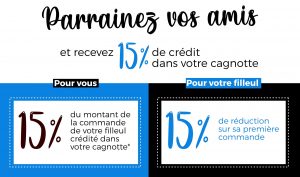GPON vs EPON, what is the difference?
GPON vs EPON, what is the difference?
With the rapid development of fiber-to-the-home (FTTH), Gigabit passive optical networks (GPON) and Ethernet passive optical networks (EPON) are becoming more and more popular in the market. Both GPON and EPON are part of PON, which are developed separately by ITU-T and IEEE to enable Gigabit throughput solutions to provide Ethernet and IP services. Many people want to know more about the difference between GPON and EPON when making a decision. Fortunately, in this article, we will make a comparison from five aspects.

1. GPON vs EPON, what is the difference?
With the rapid development of fiber-to-the-home (FTTH), Gigabit passive optical networks (GPON) and Ethernet passive optical networks (EPON) are becoming more and more popular in the market. Both GPON and EPON are part of PON, which are developed separately by ITU-T and IEEE to enable Gigabit throughput solutions to provide Ethernet and IP services. Many people want to know more about the difference between GPON and EPON when making a decision. Fortunately, in this article, we will make a comparison from five aspects.
2. Introduction of V-SOL 4G CPE
1. Data rate
GPON supports multiple data rate levels, including asymmetric uplink and downlink rates, 2,5 Gbps or 1,25 Gbps downlink, 1,25 Gbps or 622 Mbps uplink. Users can determine the uplink and downlink rates according to their actual needs, select the corresponding optical transceiver, and improve the cost of the optical device.
EPON provides a fixed throughput of 1,25Gbps in uplink and downlink and adopts 8b/10b line coding but the actual throughput is 1Gbps.
Verdict: GPON is better than EPON.
2. Division ratio
GPON supports 1:32, 1:64, 1:128 ratios. There are multiple selectivities but the advantage in terms of cost is not obvious. The maximum physical distance that a GPON system can support is 20 km when the optical split ratio is 1:16. When it comes to 1:32, the maximum physical distance should be 10 km.
EPON has 1:16~1:32. In fact, it can also achieve higher split ratio, such as 1:64, 1:128 and EPON OLT can support more EPON ONU. But the split ratio is mainly limited by the performance of the optical module, because high split ratio increases the cost of the optical module. When the insertion loss of PON is 15-18 dB, a high division ratio reduces the transmission distance. So, many users choose to share bandwidth.
Verdict: equal
3. QoS (quality of service)
GPON has integrated QoS management involving Ethernet, TDM and ATM, which is a great advantage for many operators. Additionally, GPON has greater bandwidth than EPON. Its service support is more efficient and the division capacity is stronger. It can transmit services at higher bandwidth, allow wider access to users, guarantee multi-service and quality of service.
EPON does not have any inherent QoS capabilities. However, PON systems are not really viable for operators without some form of QoS. This is why many providers that use EPON choose to use Virtual Local Area Network (VLAN) tags to solve this problem. However, this solution can be very expensive.
Verdict: GPON is superior to EPON.
4. Operation and maintenance (OAM)
GPON has powerful OAM capabilities. Three types of OAM channels, including integrated OAM channels, PLOAM and OMCI, are provided from the perspectives of consumer demand and operator operation and maintenance management, which forms a C plan /M (control/management plane) supporting different tasks. For example, PLOAM is responsible for data encryption, state detection, error monitoring, etc.
EPON simply uses optional support such as ONT far-end fault indication, loopback, and link monitoring instead of placing excessive emphasis on OAM.
Verdict: GPON OAM is more robust.
5. Costs
The cost of GPON or EPON depends on the OLT, ONU/ONT and passive optical components. The price of different GPON OLT or EPON OLT is also different. For the same number of users, the cost of fiber and cabinet with EPON is similar to that of GPON. The cost of OLT and ONT is determined by the ASIC (Application Specific Integrated Circuit) and optical transceiver modules. The GPON chipsets available on the market are mostly based on FPGAs (Field Programmable Gate Array), which are more expensive than the ASICs of the MAC (Media Access Control) layer of the EPON. In addition, the optical module of EPON is cheaper than that of GPON.
Verdict: EPON is more cost-effective than GPON.
3. Related Product
ELFCAM has developed a series of GPON and EPON products according to demand. There are not only EPON/GPON ONU/OLTs, but also xPON ONU routers that support dual modes including EPON and GPON.

Tags: sc apc
Related posts
-
 Q&A E-solutionQ&A ELFCAM SOLUTION 1. OEM, ODM service is available? If MOQ=3KPCS, we can offer...
Q&A E-solutionQ&A ELFCAM SOLUTION 1. OEM, ODM service is available? If MOQ=3KPCS, we can offer... -
 What is ONU EPON (GEPON): Functions and typesWhat is EPON ONU (GEPON): Functions and Types EPON ONU is a device that...
What is ONU EPON (GEPON): Functions and typesWhat is EPON ONU (GEPON): Functions and Types EPON ONU is a device that...










